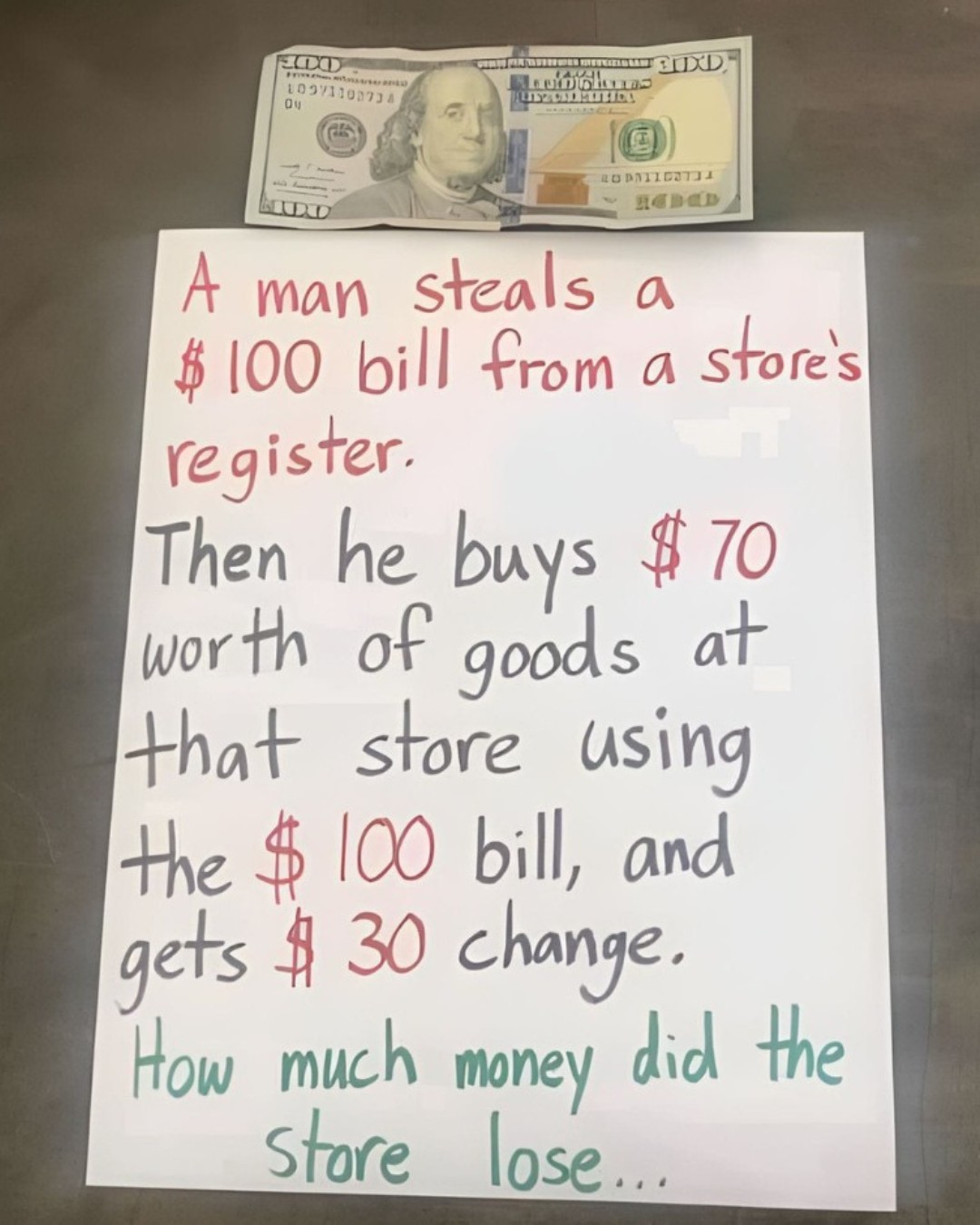
Brain teasers are a fun and engaging way to challenge your thinking and problem-solving skills. They often present scenarios that require logical reasoning, creativity, and sometimes a bit of lateral thinking. One viral brain teaser that has captivated many involves a store, a product, and a seemingly simple question: How much money did the store lose? In this article, we’ll explore the intricacies of this brain teaser, break down the scenario, and guide you through the process of finding the solution.
The Scenario
Imagine a store that sells a particular product for 100.Oneday,acustomerwalksintothestoreandbuysthatproduct.Tomakethepurchase,thecustomerhandsthecashiera100. One day, a customer walks into the store and buys that product. To make the purchase, the customer hands the cashier a 100.Oneday,acustomerwalksintothestoreandbuysthatproduct.Tomakethepurchase,thecustomerhandsthecashiera100 bill. The cashier, in a hurry, accidentally gives the customer 110inchangeinsteadof110 in change instead of 110inchangeinsteadof0.
After realizing the mistake, the store owner is left wondering how much money the store actually lost in this transaction. Was it just the $10 in extra change, or is there more to the story?
Breaking Down the Problem
To solve this brain teaser, we need to analyze the transaction step-by-step. Let’s break it down into parts:
Step 1: The Sale
The customer pays $100 for the product.
The store receives $100 in cash.
At this stage, the store has made a sale and has $100 in cash.
Step 2: The Change Given
The cashier mistakenly gives the customer $110 in change.
Now, let’s consider how much cash the store has after this mistake:
The store initially had $100 from the sale.
After giving the customer 110inchange,thestoreisnowdown110 in change, the store is now down 110inchange,thestoreisnowdown110
Step 3: Calculating the Financial Impact
To understand the overall financial impact of this transaction, we need to consider both the sale and the change given:
The store received 100butthengaveaway100 but then gave away 100butthengaveaway110.
Therefore, the net cash flow for the store from this transaction is:
Net Cash Flow=Cash Received−Cash Given=100−110=−10\text{Net Cash Flow} = \text{Cash Received} – \text{Cash Given} = 100 – 110 = -10Net Cash Flow=Cash Received−Cash Given=100−110=−10
This indicates that the store has lost $10 in cash.
Step 4: The Value of the Product
Now, it’s crucial to consider that the customer also took the product, which has a value of $100. This means we need to factor in the cost of the product to determine the total loss to the store:
The store lost $10 in cash.
The store also lost the $100 product.
Total Loss Calculation
To calculate the total loss:
Cash loss: $10
Value of the product: $100
Thus, the total loss can be expressed as:
Total Loss=Cash Loss+Value of Product=10+100=110\text{Total Loss} = \text{Cash Loss} + \text{Value of Product} = 10 + 100 = 110Total Loss=Cash Loss+Value of Product=10+100=110
So, the store’s total loss from this transaction amounts to $110.
The Trick Behind the Teaser
This brain teaser plays on the simplicity of the situation while hiding the complexity of what constitutes a loss. Many people might initially jump to the conclusion that the store only lost $10 due to the error in change. However, by considering the value of the product taken by
Reflection on the Teaser
This kind of brain teaser is effective because it encourages critical thinking and emphasizes the importance of considering all aspects of a situation. In real-world scenarios, understanding the full impact of a transaction is vital for effective business management.
Why Are Brain Teasers Important?
Engaging with brain teasers like this one has several benefits:
Enhances Problem-Solving Skills: They encourage you to think critically and analyze problems from different angles.
Improves Cognitive Flexibility: Brain teasers require you to adjust your thinking and approach, which can improve cognitive flexibility.
Boosts Creativity: They often require lateral thinking, which fosters creativity and innovation.
Increases Focus: Solving these puzzles demands concentration and can help improve your focus over time.
Other Examples of Brain Teasers
If you enjoyed this brain teaser, here are a few more examples to challenge your thinking:
Example 1: The Missing Dollar Riddle
Three friends go to a restaurant and order a meal that costs 30.Theyeachcontribute30. They each contribute 30.Theyeachcontribute10. After they pay, the waiter realizes the meal was only 25andgivesback25 and gives back 25andgivesback5. The friends decide to give 1backtoeachpersonandkeeptheremaining1 back to each person and keep the remaining 1backtoeachpersonandkeeptheremaining2 as a tip for the waiter. Now, each friend has paid 9,totaling9, totaling 9,totaling27. Adding the 2tipmakesit2 tip makes it 2tipmakesit29. Where is the missing dollar?
Example 2: The Two Doors Riddle
You are in a room with two doors: one leads to freedom, and the other leads to certain death. You don’t know which is which. There are two guardians: one always tells the truth, and the other always lies. You can ask one guardian one question. What question do you ask to find the door to freedom?
Example 3: The Light Switch Problem
You are in a room with three light switches that control three light bulbs in another room. You can’t see the bulbs from the switch room. You can flip the switches as many times as you want, but you can only enter the bulb room once. How do you determine which switch controls which bulb?
Conclusion
Understanding the intricacies of brain teasers not only enhances your problem-solving skills but also sharpens your critical thinking abilities. The viral brain teaser about the store and the money lost teaches us a valuable lesson in considering all aspects of a situation before jumping to conclusions.
By practicing with brain teasers, you can improve your cognitive skills while enjoying the challenge of unraveling complex scenarios. The next time you face a seemingly simple question, remember to look deeper and consider all possibilities—you might be surprised by what you find!
Feel free to share your thoughts on this brain teaser or ask for more examples to challenge your mind!